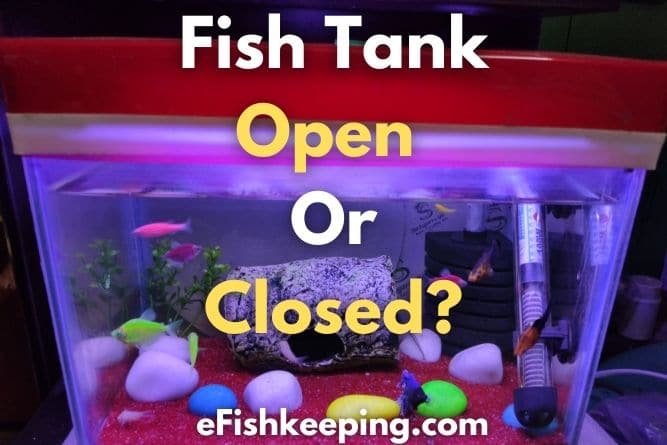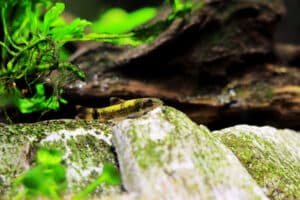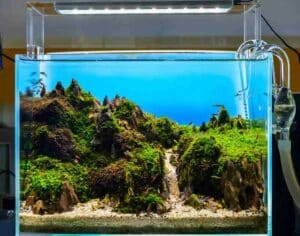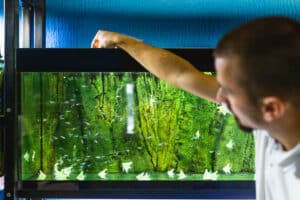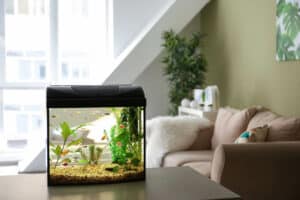So you bought a new fish tank and got it all set up.
I’m sure it’s looking nice 🙂
But what about the top cover of the tank? Can you completely cover a fish tank?
Typically, you can completely cover a fish tank provided there is a few inches of space left between the water level and top cover. Also, the cover must be applied in a way that allows the air exchange between the fish tank water surface and the surrounding.
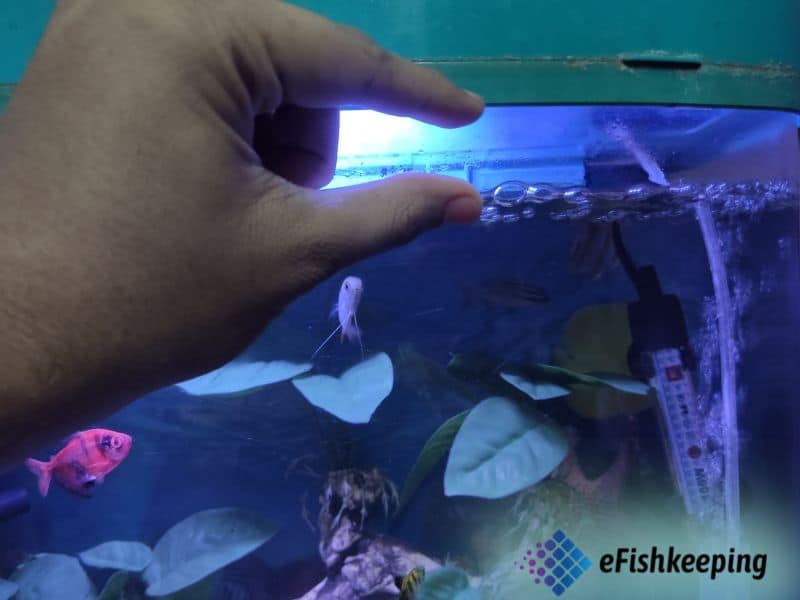
A fish tank cover is recommended because it protects the tank system from the outer surrounding. A cover also reduces the rate of water evaporation.
However, from an aesthetic standpoint, it is acceptable to keep a fish tank without a cover as long as proper care is taken.
Keeping a fish tank open or closed has both pros and cons. Continue reading to learn more and choose the best option for your needs.
Advantages of having a closed fish tank
1. Prevents unwanted items entering the tank
It’s possible that you’ve kept your fish tank in an area with heavy decoration items stacked on top of it. If the fish tank is not covered by a lid or hood, heavy items can fall inside and injure your fish.
Dirt and debris can also accumulate on the tank’s surface.
2. Prevents fish from jumping out of the tank
Aquarium fish can be a little too enthusiastic at times. As a result, they may occasionally jump out of the tank out of curiosity.
Take extra precautions if you’re dealing with energetic fish, such as those known for their impressive jumping abilities.
For instance, if you kept betta fish, it is good a idea to cover your tank because they are known to jump high and sometimes even escape a tank.
3. Prevents the tank water from splashing out
As you probably water is good conductor of electricity. So you don’t want water to come in contact with your electrical components.
If you have an arrangement like me where I have kept the electrical board a few inches above the fish then it is must to have a cover for safety.
And not just that, you won’t like to break your legs because the tank water splashed out on the floor, right?
Therefore it is good to keep a lid or hood and prevent the fish tank water coming out.
4. Slows down the rate of tank water evaporation
This is a scientific reason and probably the most important why you need a fish tank cover.
Evaporation is the process in which the surface water changes into gaseous phase. Here’s how a cover on your fish tank slows down the tank water evaporation.
Water condenses on your fish tank cover and re-enters the fish tank instead of getting evaporated. This reduces the necessity of adding more water frequently.
Isn’t it a good thing? So you should definitely cover your tank unless you want to add water more frequently.
5. Helps to retain the heat inside the tank
The hood or the lid of your fish can also help to hold the heat inside the tank. Although a heater is enough to maintain your fish tank temperature.
Still, especially in winters it can cause an added benifit and help to retain the heat inside the fish tank system.
6. Keeps your curious pets away from the tank
If you have pets in your home especially cats then you should take care. It may happen that you are away from your tank and your pet cat takes this opportunity to play with your tank fish.
Although it depends on how curious your cats but still it good to take prevention. You don’t want your cats mess with the aquarium water and decorations, right?
7. Prevents the odor of fish tank from coming out
When you haven’t cleaned your fish tank for long then you might feel an awkward smell coming out of the tank. And in most cases, you won’t like this smell.
So at that time the fish tank cover proves to be beneficial and helps in preventing the fish tank odor from getting mixed with the outside environment.
Also read my article: Can I leave my aquarium light on 24 7?
Disadvantages of having a closed fish tank
1. Doesn’t look so good
The fish tank cover has many benefits but most often they are bulky and might not look so beautiful compared to the open tanks. Although this is a subjective thing but still this is a disadvantage.
The fish tank with a closed container might appear like a closed container box. But don’t worry there are ways to design it or choose its color in such a way that it blends with the background.
For example, at our home, since we have put a fish tank under a TV with a black screen. So it made quite a sense to have a black cover that blends with the background. In a similar way, you can think about your aquarium.
2. Always have to open the lid to do anything
Whether you want to feed your fish, add water, or do anything else you have to open the cover first, and then only you can do anything.
If there was no cover then you could just do the task without an added step of removing the cover. Right?
Advantages of having an open fish tank
1. Looks very beautiful
Yes, open aquariums look very beautiful because of being simple and sleek. The aquarium looks more natural when it is without a lid instead of seeming like a container box.
Moreover, you get more options to decorate your tank because even tall plants that grow above the water and big stones can be added.
2. Hassle-free maintenance
If you are a guy who spends lots of his time in front of the tank, wetting the hands, doing some tweaks.
Then probably, having a cover can disturb you a lot because every time you have to take it away and again place it back when your work is done.
Whereas, in open tanks, you can just dip your hands and do whatever you want. Isn’t that a hassle-free thing?
3. Adds another dimension
Yes, you can get another dimension to look at your aquarium from the top. It may be interesting for you to look at your fish and the plants from a different angle.
4. Less cost compared to the closed one
Since, the open tanks only include the aquarium and not the lids. So cost of the lids or covers can be saved.
Also Read: Aquarium Air Pump Placement Guide
Disadvantages of having an open fish tank
1. All the advantages of a closed fish tank will be missed
Since there’s no lid or hood to cover the tank, the chances of fish jumping out, water splashing out, your pets getting interested in the tank, debris or heavy objects falling inside, the odor coming out, an increased rate of evaporation will increase.
Fish Tank Open Or Closed – Which To Choose?
If you are a beginner then it is recommended to get a closed tank because it has many advantages and it is safe for your fish. However, if you are a little experienced, spent most of your time near your fish tank, care more about the beauty, then you can go for an open tank.
Note that you can cover a fish tank completely as long as the fish tank is not sealed or fully air tight. The idea is to place the cover in such a way that the air can get inside the fish tank and oxygen exchange can happen at the tank surface.
There are many advantages of having a closed fish tank. The only disadvantage is you have to compromise with beauty and little extra work of removing the cover every time you want to feed, clean, or any other work with your tank.
But the pros are much higher compared to the cons for a closed fish tank. Also, the cons are not that major concerns.
So if you are a beginner and just looking for advice on whether you should cover your fish tank or not. Then my answer would lean more towards yes.
At our home, we have three aquariums and all of them are covered. In fact, we rarely had a tank that we didn’t cover because I and my dad, personally like to have a covered fish tank.
Now, for the open fish tank. It has many aquascaping opportunities because you can even choose plants that grow out of the water (there’s no lid or cover to block it).
And if you have seen the beautiful aquariums online then mostly they are the open ones, isn’t it?
But I would only recommend them if you are a little experienced in this hobby and you are really concerned about your fish tank aesthetic.
Long story short, whatever you do make sure that you taking the proper care of your fish along with not disturbing the beauty of your tank.
Related Questions
Should I Cover My Fish Tank At Night?
Yes, it is recommended to cover a fish tank, especially at night because the fish can jump outside. The tank owner can’t even know about it unless waking up in the morning and noticing the dead fish lying on the floor. So it is better to take precautions.
If for some reason you don’t have choice but to leave the tank open for whole night, try this temporary solution. Take a long bath towel or light cloth and drape it over the fish tank.
The cloth should be light enough to allow air to pass through and reach the tank. Applying this tip, fish will assume that at least there is some barrier over the tank. So they won’t try jump out off the tank so easily.
But a better solution is to make plastic covers (with lid or holes for air passage) for your fish tank based on the size of your tank top.
Can You Leave The Lid Off A Fish Tank?
Yes, it is fine to leave the lid off a fish tank. However, proper care must be taken because without a lid the fish can jump out of the tank.
Also, water can splash out on the floor or something can fall inside the fish tank.
Does A Fish Tank Lid Need Holes?
It is not mandatory to have holes in the lid unless the lid is sealed tightly and there’s no way for outside air to enter the tank.
Although the filters and air pumps are sufficient to provide the aeration still, it is important to allow the passage of some fresh air inside the tank. At least one finger-sized hole is needed for feeding and air ventilation.
How Much Space Should You Leave At The Top The Fish Tank?
Generally, it is recommended to have at least a 1-inch gap between the top of a fish tank and the water level. Doing this prevents the fish from bumping their head, every time they come up, and also it is good for aeration.
Remember that oxygen gets dissolved in the tank water when it’s top surface is agitated.
Air stones (bubblers), and sponge filters, are the devices that help in disturbing the top layer of the tank and facilitating the oxygen exchange.
If there is no space between the top water layer of the tank and the tank top rim, the water layer won’t agitate properly. As a result, oxygenation won’t happen efficiently and the fish could start gasping by swimming at the top of the tank.
So it’s best to leave at least some gap so that water movement can happen at the tank top and oxygen exchange happens with ease.
Recommended Reading:
Thanks! Have a happy fishkeeping day!
Hi! I’m Praveen Ghoshal, the founder of eFishkeeping.com. Inspired by my Dad, I got interested in fishkeeping when I was a kid. Since then, I have been involved with this hobby. Currently, I have 3 fish tanks at our home, and I enjoy this hobby with my full family. Read more about me here.

